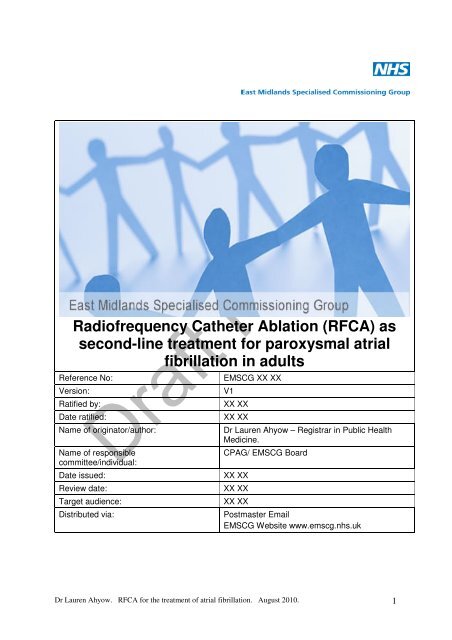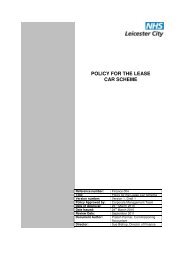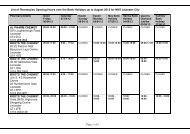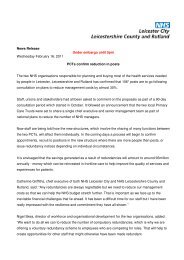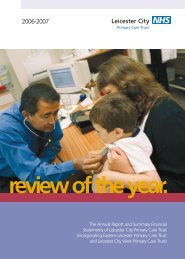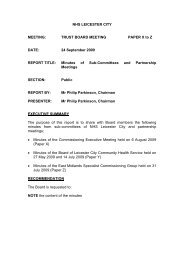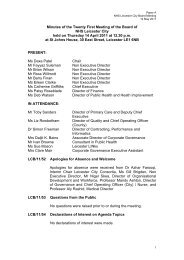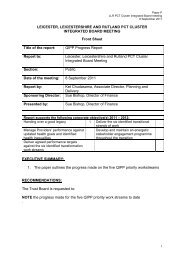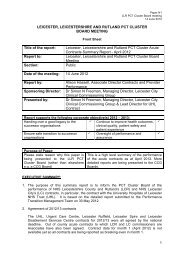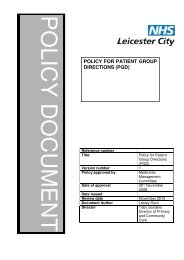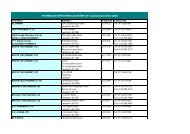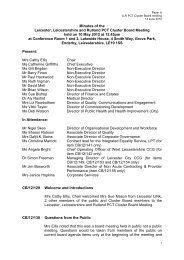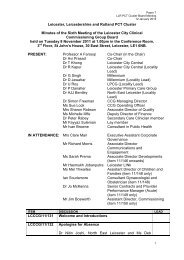Radiofrequency Catheter Ablation (RFCA) as second-line ... - NHS
Radiofrequency Catheter Ablation (RFCA) as second-line ... - NHS
Radiofrequency Catheter Ablation (RFCA) as second-line ... - NHS
You also want an ePaper? Increase the reach of your titles
YUMPU automatically turns print PDFs into web optimized ePapers that Google loves.
12. Estimating regional costs from local practiceCardiologists at Glenfield Hospital (UHL <strong>NHS</strong> Trust) perform approximately 200 <strong>RFCA</strong>procedures per year, for patient with both with paroxysmal and persistent AF. GlenfieldHospital provides tertiary cardiac services for an estimated population of 979,750 (combinedregistered population of Leicestershire County and Rutland and Leicester City PCTs). B<strong>as</strong>ed onthese crude data, the estimated incidence is 2.04 per 10,000 person years (<strong>as</strong>suming that all<strong>RFCA</strong> patients are drawn from the two PCT populations, and that patients within the two PCTsdo not access tertiary cardiology centres in other localities). If this crude incidence estimate isextrapolated to the E<strong>as</strong>t Midlands population (<strong>as</strong>suming that both the AF and wider populationsof Leicester/Leicestershire are representative of the region), the estimated incidence of <strong>RFCA</strong>procedures is 714 per year. (Age specific rates are required to make more precise estimates –these data are not currently available). Data from Glenfield shows that approximately 25% of<strong>RFCA</strong> procedures are for persistent AF vs 75% for paroxysmal. Overall Glenfield’s recurrencerate is 14% (25% in literature). The average patient age is 59 (range 38 – 79). 4713. Cost per c<strong>as</strong>eThe procedural cost estimate of £5436 h<strong>as</strong> been provided by STH <strong>NHS</strong> Tust. The cost andprobability of complications have been distributed across all patients and all have been<strong>as</strong>sumed to occur in the first year, resulting in an estimated cost of £6875 per patient for the first12 months (<strong>as</strong>suming a repeat ablation in 25% of patients). The cost per patient may be slightlylower (£6286) if the rate of AF recurrence is lower (14% - <strong>as</strong>suming this translates to lower ratesof repeat ablation in the medium term) Applying data from current literature annual follow upcosts have been estimated <strong>as</strong> £471 in year one and £72 per annum thereafter.The age range of selected patients, the arrhythmia type (paroxysmal vs persistent) and providerperformance have important cost implications which are illustrated in Tables 4 & 5.Table 4.Assuming 25% repeat ablation. Crude projected costs for current practice (paroxysmal andpersistent = 698/year) compared to paroxysmal only (524/year), in all patients over 45 years .Figures also shown for current practice (paroxysmal and persistent = 120/year) compared toparoxysmal only(90/year) for patient population aged 45-65 years (in red).YrpolicyfromOver 45 yrs(Paroxysmal75% Persistent25%)Over 45 yrsParoxysmalOnlyCostsaving45-65yrs(Paroxysmal75%Persistent25%)45-65yrsParoxysmalOnlyCostsavingYr 1 4,798,750 3,602,500 1,196,250 825,000 618,750 206,250Yr 2 5,127,508 3,849,304 1,278,204 881,520 661,140 220,380Yr 3 5,177,764 3,887,032 1,290,732 890,160 667,620 222,540Yr 4 5,228,020 3,924,760 1,303,260 898,800 674,100 224,700Dr Lauren Ahyow. <strong>RFCA</strong> for the treatment of atrial fibrillation. August 2010. 10
8. The prevalence of AF in the UK is rising and demand for <strong>RFCA</strong> is likely to incre<strong>as</strong>ebeyond that which affordable.16. Recommendations:Services to provide this treatment may be commissioned by E<strong>as</strong>t Midlands SpecialisedCommissioning Group in accordance with regional priority setting. In accordance with NICE CG36 and NICE IPG 168, this treatment should only be funded* by the E<strong>as</strong>t Midlands SpecialisedCommissioning Group in patients who meet all of the following criteria:1) The patient h<strong>as</strong> severely symptomatic and debilitating paroxysmal atrial fibrillationwhich h<strong>as</strong> a significant impact on the patient’s quality of life, indicated by frequent andprolonged episodes of EHRA Cl<strong>as</strong>s III or IV.AND2) The patient’s symptoms are refractory (ineffective or intolerant) to two or more antiarrhythmicdrugs (including ß-blockers), <strong>as</strong> recommended by the NICE Clinical Guide<strong>line</strong>36: management of atrial fibrillation.AND3) The patient h<strong>as</strong> been referred to an experienced interventional cardiologist with specifictraining in electrophysiology and performing complex ablation procedures, at a centrewith arrangements for emergency cardiac surgical support in c<strong>as</strong>e of complications.AND4) The patient h<strong>as</strong> discussed with the specialist interventional cardiologist, realisticexpectations of the effectiveness including an acceptance of a 5% risk of seriouscomplications and the potential requirement of a <strong>second</strong> ablation procedure.AND5) The patient h<strong>as</strong> an absence of severe structural heart dise<strong>as</strong>e on echocardiography,including the absence of a severely dilated left atrium (maximum 5.5 cm).AND6) The patient does not meet any of the following exclusion criteria17. Exclusion criteria• Permanent or Persistent AF• Patient is due to undergo heart surgery (e.g. value repair/CABG) and would bean appropriate c<strong>as</strong>e for concomitant surgical ablation (cox maze)• Severe and/or irreversible structural heart dise<strong>as</strong>e• Left atrial thrombus on echocardiography• NYHA cl<strong>as</strong>s IV congestive heart failure• Life expectancy less than 5 yearsDr Lauren Ahyow. <strong>RFCA</strong> for the treatment of atrial fibrillation. August 2010. 13
If robust trial evidence can be provided, which demonstrates clinical and costeffectiveness of <strong>RFCA</strong> inpatients with ‘persistent’ AF, commissioners may considerfunding a limited number of ‘persistent’ patients under special arrangements.All patients should be recorded prospectively and centrally by the Central Cardiac AuditDatab<strong>as</strong>e (in concordance with the NIHR HTA Programme’s recommendations)**Given the uncertainty in the crude estimates of demand and cost it is recommended thatany annual contract is reviewed in light of demand and further evidence after one year.<strong>RFCA</strong> procedures should require prior approval by all regional PCTs, in order to <strong>as</strong>sistcontract management and quarterly service audit.*Providers may independently fund this procedure in patients excluded under the terms of thispolicy in accordance with NICE IPG guidance. Alternatively clinicians can apply for funding inpatients who do not fulfil the criteria <strong>as</strong> set out in this policy, if they can demonstrateexceptionality under the terms of ‘Individual Funding Request’ policies.**This would be of particular value in establishing the long term benefits, the true incidence ofcomplications and the clinical and cost-effectiveness of <strong>RFCA</strong>.18. MonitoringPerformance management of this commissioning policy should be b<strong>as</strong>ed on the NICE CG 36audit criteria.Date of policy: XX XXReview date: XX XXDr Lauren Ahyow. <strong>RFCA</strong> for the treatment of atrial fibrillation. August 2010. 14
30. Oral H, Pappone C, Chugh A, Good E, Bogun F, Pelosi F, et al. Circumferentialpulmonary-vein ablation for chronic atrial fibrillation. New England Journal of Medicine.2006;354(9):934-41.31. Stabile G, Bertaglia E, Senatore G, De Simone A, Zoppo F, Donnici G, et al. <strong>Catheter</strong>ablation treatment in patients with drug-refractory atrial fibrillation: a prospective, multicentre,randomized, controlled study (<strong>Catheter</strong> <strong>Ablation</strong> For The Cure Of AtrialFibrillation Study). European Heart Journal. 2006;27(2):216-21.32. Wazni OM, Marrouche NF, Martin DO, Verma A, Bhargava M, Saliba W, et al.<strong>Radiofrequency</strong> ablation vs antiarrhythmic drugs <strong>as</strong> first-<strong>line</strong> treatment of symptomaticatrial fibrillation - A randomized trial. Jama-Journal of the American Medical Association.2005;293(21):2634-40.33. Pappone C, Augello G, Sala S, Gugliotta F, Vicedomini G, Gulletta S, et al. Arandomized trial of circumferential pulmonary vein ablation versus antiarrhythmic drugtherapy in paroxysmal atrial fibrillation - The APAF study. Journal of the AmericanCollege of Cardiology. 2006;48(11):2340-7.34. Krittayaphong R, Raungrattanaamporn O, Bhuripanyo K, Sriratan<strong>as</strong>athavorn C,Pooranawattanakul S, Punlee K, et al. A randomized clinical trial of the efficacy ofradiofrequency catheter ablation and amiodarone in the treatment of symptomatic atrialfibrillation. J Med Assoc Thai. 2003;86 Suppl 1:S8-16.35. Jais P, Cauchemez B, Macle L, Daoud E, Khairy P, Subbiah R, et al. <strong>Catheter</strong> <strong>Ablation</strong>Versus Antiarrhythmic Drugs for Atrial Fibrillation The A4 Study. Circulation.2008;118(24):2498-505.36. Wyse DG, Waldo AL, DiMarco JP, Domanski MJ, Rosenberg Y, Schron EB, et al. Acomparison of rate control and rhythm control in patients with atrial fibrillation. NewEngland Journal of Medicine. 2002;347(23):1825-33.37. Corley SD, Epstein AE, DiMarco JP, Domanski MJ, Geller N, Greene HL, et al.Relationships between sinus rhythm, treatment, and survival in the atrial fibrillationfollow-up investigation of rhythm management (AFFIRM) study. Circulation.2004;109(12):1509-13.38. Moyle GJ. Truth, lies, and statistical tests. AIDS Read. 2003;13(3):117-8, 23-4, 26.39. Lamotte M, Annemans L, Bridgewater B, Kendall S, Siebert M. A health economicevaluation of concomitant surgical ablation for atrial fibrillation. European Journal ofCardio-Thoracic Surgery. 2007;32:702-10.40. McKenna C, Palmer S, Rodgers M, Chambers D, Hawkins N, Golder S, et al. Costeffectivenessof radiofrequency catheter ablation for the treatment of atrial fibrillation inthe United Kingdom. Heart (London). 2009;95(7):542-9.41. Khaykin Y, Morillo CA, Skanes AC, McCracken A, Humphries K, Kerr CR. Costcomparison of catheter ablation and medical therapy in atrial fibrillation. Journal ofCardiov<strong>as</strong>cular Electrophysiology. 2007;18(9):907-13.42. Khaykin Y, Wang XY, Natale A, Wazni OM, Skanes AC, Humphries KH, et al. CostComparison of <strong>Ablation</strong> Versus Antiarrhythmic Drugs As First-Line Therapy for AtrialFibrillation: An Economic Evaluation of the RAAFT Pilot Study. Journal of Cardiov<strong>as</strong>cularElectrophysiology. 2009;20(1):7-12.Dr Lauren Ahyow. <strong>RFCA</strong> for the treatment of atrial fibrillation. August 2010. 17
43. Weer<strong>as</strong>ooriya R, Jais P, Le Heuzey JY, Scavee C, Choi KJ, Macle L, et al. Cost analysisof catheter ablation for paroxysmal atrial fibrillation. Pace-Pacing and ClinicalElectrophysiology. 2003;26(1):292-4.44. Reynolds MR, Brown PP, Kugelm<strong>as</strong>s AD, Cohen DJ, Simon AW, Culler SD. Frequencyand cost of complications of catheter ablation for atrial fibrillation in medicare patients.Circulation. 2008;117(21):214.45. Andrikopoulos G, Tzeis S, Maniadakis N, Mavrakis HE, Vard<strong>as</strong> PE. Cost-effectivenessof atrial fibrillation catheter ablation. Europace. 2009;11(2):147-51.46. Knight H. Personal Communication. Derbyshire County PCT. 2009.47 Stafford P. Personal Communication. Glenfield Hospital. UHL <strong>NHS</strong> Trust. May 2010.48 NCHOD. GP registered data. 2008.49. Cappato R, Calkins H, Chen SA, Davies W, Kalman J, Kim Y, et al. A worldwide surveyon the methods, efficacy and safety of catheter ablation for human atrial fibrillation.European Heart Journal. 2004;25:273-.50. al CHe. HRS/EHRA/ECAS expert consensus statement on catheter and surgicalablation of atrial fibrillation: recommendations for personnel, policy, procedures andfollow-up. A report of the Heart Rhythm Society (HRS) t<strong>as</strong>kforce in catheter and surgicalablation of atrial fibrillation. Heart Rhythm2007. p. 816-61.51. Flaker GC, Fletcher KA, Rothbart RM, Halperin JL, Hart RG. CLINICAL ANDECHOCARDIOGRAPHIC FEATURES OF INTERMITTENT ATRIAL-FIBRILLATIONTHAT PREDICT RECURRENT ATRIAL-FIBRILLATION. American Journal ofCardiology. 1995;76(5):355-8.52. Phillips SJ, Whisnant JP, Ofallon WM, Frye RL. PREVALENCE OFCARDIOVASCULAR-DISEASE AND DIABETES-MELLITUS IN RESIDENTS OFROCHESTER, MINNESOTA. Mayo Clinic Proceedings. 1990;65(3):344-59.53. Kannel WB, Abbott RD, Savage DD, McNamara PM. CORONARY HEART-DISEASEAND ATRIAL-FIBRILLATION - THE FRAMINGHAM-STUDY. American Heart Journal.1983;106(2):389-96.54. Wilber DJ, Pappone C, Neuzil P et al. Comparison of antiarrhythmic drug therapy and<strong>RFCA</strong> inpatients with paroxysmal AF: a randomized controlled trial. JAMA; 303(4):333-34055. Packer DL, Lee KL, Mark DB, Monahan KH, Hoffmann KL, Hafley GE, Poole JE,Bahnson TD, Bradley DJ, Robb R, Rettmann M, Holmes III DR, Stevenson W, HummelJD, Bailin SJ, Day JD, Bhandari AK, Marchlinski F, Kay N, Calkins H, Wilber DJ.<strong>Catheter</strong> <strong>Ablation</strong> vs Antiarrhythmic Drug Therapy for Atrial Fibrillation: Results of theCABANA Pilot Study ACC Atlanta March 15, 201056. R J Hunter, T J Berriman, I Diab, V Baker, M Finlay, L Richmond, E Duncan, R Kamdar,G Thom<strong>as</strong>, D Abrams, M Dhinoja, S Sporton, M J Earley, R J Schilling. Long-termefficacy of catheter ablation for atrial fibrillation: impact of additional targeting offractionated electrograms. Heart On<strong>line</strong> First, published on May 18, 2010 <strong>as</strong>10.1136/hrt.2009.188128.57. Dagres N, Varounis C, Flevari P, Piorkowski C, Bode K, Rallidis LS, Tsougos E,Leftheriotis D, Sommer P, Hindricks G, Krem<strong>as</strong>tinos DT. Mortality after catheter ablationDr Lauren Ahyow. <strong>RFCA</strong> for the treatment of atrial fibrillation. August 2010. 18
for atrial fibrillation compared with antiarrhythmic drug therapy. A meta-analysis ofrandomized trials. Am Heart J. 2009;158:15-20.58. Dorian P, Guerra PG, Kerr CR, O’Donnell SS, Crystal E, Gillis AM, Mitchell LB, Roy D,Skanes AC, Rose MS, Wyse DG. The Canadian Cardiov<strong>as</strong>cular Society Severity inAtrial Fibrillation Scale. Circ Arrhythm Electrophysiol 2009;2;218-224.59. Jackson PJ. Personal Communication. August 2010.60. Wokhlu A et al. Long-term quality of life after ablation of atrial fibrillation. JACC2010;55(21)2308-2316.Dr Lauren Ahyow. <strong>RFCA</strong> for the treatment of atrial fibrillation. August 2010. 19
practices which have been preparedwith the <strong>as</strong>sistance of the Florida IrrigationSociety and other Florida landscapeand irrigation stakeholders. No deed restriction, covenant and/orlocal government ordinance, may prohibitor be enforced so <strong>as</strong> to prohibitany property owner from implementinga Florida-friendly landscape (or efficientirrigation system) on his or her property.Covenants and Restrictions” manual(www.dep.state.fl.us/water/non-point/docs/nonpoint/ffl-mo-ccr-1-09.pdf), “The Florida Friendly BestManagement Practice for Protectionof Water Resources by the GreenIndustries”(www.dep.state.fl.us/water/non-point/docs/nonpoint/grn-ind-bmp-en-12-2008.pdf) and many other FDEPmaterials and documents. These FDEPmaterials and documents include efficientirrigation system standards,guide<strong>line</strong>s and other water-conservingThere are numerous other minorirrigation bill/law items that you, <strong>as</strong>true FIS irrigation professionals, mayneed to be concerned with. However,the above is meant to dispel much ofthe misinformation concerning thesebills/laws. Take this information andcitations to your local municipal orcounty government and/or watermanagement district to <strong>as</strong>sure theirproper implementation. Should anyoneneed more information, clarification,etc., contact me through theFlorida Irrigation Society.35 YEARS THE SIMPLEST, LOWEST COST PUMP PROTECTION• ONE SIZE FITS ALL• N.O., N.C., SPDT SWITCHES• MANUAL OR AUTOMATIC RESET• STRAP OR _MNPT CONNECT• WIRELESS AVAILABLE• LOW COST 24VAC MODELINOV8, INC. • 427 SOUTHERN BOULEVARD • WEST PALM BEACH, FL • 33408PHONE: (561) 833-3988 • FAX: (561) 622-0457 • E-mail: inov82@aol.com20 PIPELINE
A recent cohort study of 285 consecutive patients between 2002-2007 (Hunter et al) 56 comparedtreatment success rates in paroxysmal versus persistent AF; after one treatment, a cluster oftreatments, and at 6 months off drugs. At all stages success rates in persistent were 20%(absolute difference) lower compared to paroxysmal. In each treatment group these findingswere highly statistically significant. Overall treatment success rates were lower in patients withpersistent AF (68%) compared to paroxysmal (86%). The mean number of procedures w<strong>as</strong>higher for persistent (2.0) compared to paroxysmal (1.7). Multivariate analysis identified femalesex (p
A recent Markov model b<strong>as</strong>ed on data from three of the above mentioned RCTs reportedconservative estimates of single procedure efficacy of 60% (40% AF recurrence in one year)with a 25% rate of repeat ablation. The authors acknowledged that experienced centresreported better results but that these estimates are probably representative of current practiceoverall. (9)Effects of <strong>RFCA</strong> on specific short and long-term outcomesCardiov<strong>as</strong>cular Morbidity and MortalityCardiov<strong>as</strong>cular morbidity such <strong>as</strong> stroke, thromboembolism and congestive cardiac failure arethe most relevant clinical outcomes for patients with AF, however data on these outcomes arelacking. A recent meta-analysis of the clinical trials 57 shows no evidence of benefit in stroke riskor mortality and there is, <strong>as</strong> yet, no firm evidence that any improvement in QoL persists forlonger than 1 year.There is some evidence that the presence of NSR is <strong>as</strong>sociated with a reduction in mortality.The AFFIRM trial <strong>as</strong>sessed long term outcomes in a rhythm control strategy versus a ratecontrol strategy (using medical therapy) and found no survival benefit in one strategy comparedto the other. (36) However, reanalysis of the AFFIRM trial data (on-treatment analysis rather thanthe original intention-to-treat analysis) demonstrated that NSR w<strong>as</strong> <strong>as</strong>sociated with a reductionin the risk of death and that AADs were <strong>as</strong>sociated with a considerable incre<strong>as</strong>ed risk ofdeath. (37) The authors concluded that the benefits of maintaining NSR via AADs appeared to beoffset by serious side effects of AADs (drug toxicity). Much attention and weight h<strong>as</strong> been givento this reanalysis of the AFFIRM data. It is important to note that the 'on treatment analysis'used to demonstrate these outcomes is a ‘per protocol analysis’. This analysis tends to ignoredrop outs and undermine randomisation <strong>as</strong> well <strong>as</strong> over-estimate the treatment effect. (38) It musttherefore be treated with some caution.Larger trials with longer follow-up periods are required to provide useful information on theseoutcomes. Rhythm control h<strong>as</strong> the potential substantially to improve these long-term outcomes,but this remains to be determined. (22) A meta analysis of six RCTs found no statisticallysignificant difference for the risk of cerebrov<strong>as</strong>cular events at 12 months in those undergoing<strong>RFCA</strong>. The current evidence is insufficient to compare rates of CCF between <strong>RFCA</strong> andmedical treatment. (11) In addition, one good (1+) RCT suggests that for patients with cl<strong>as</strong>s II/IIIcongestive cardiac failure and symptomatic AF who remain symptomatic despite rate controlmedications, <strong>RFCA</strong> is an alternative to AV nodal ablation and pacemaker insertion. (10)Rhythm ControlThe evidence discussed above provides moderate evidence that <strong>RFCA</strong> is more effective thanmedication in maintaining sinus rhythm in patients with symptomatic paroxysmal (or highlyselected persistent AF) who have failed AAD therapy. Maintaining sinus rhythm may not,however, be the most important clinical outcome in many patient sub groups.Quality of LifeThere is a low level of evidence that QoL is decre<strong>as</strong>ed in AF and that maintenance of NSR maybe <strong>as</strong>sociated with improvements in QoL. Only five RCTs report any results on QoL (4: SF-36 (32, 34, 35) 1: Minnesota Heart Failure Questionnaire). Given the unblinded nature of thestudies, these self reported data on QoL are prone to bi<strong>as</strong>. Those with worst QoL at the outsetare reputed to gain most (Wokhlu) but this evidence is a little soft. 60 However <strong>as</strong> this groupconsume most health service resources because of hospital admissions 58 if their dise<strong>as</strong>e can becontrolled there is most opportunity to reduce costs.Dr Lauren Ahyow. <strong>RFCA</strong> for the treatment of atrial fibrillation. August 2010. 22
A recent meta-analysis of the clinical trials 57 shows no evidence of benefit in stroke risk ormortality and there is <strong>as</strong> yet no firm evidence that any improvement in QoL persists for longerthan 1 year. 59Resource UtilizationThere is a low level of evidence suggesting that <strong>RFCA</strong> decre<strong>as</strong>es readmission rates. One trialreported a lower readmission rate in patients treated with radiofrequency ablation than in thosereceiving medical treatment (9% vs. 54%; P < 0.001) (32) , where<strong>as</strong> the other reported nostatistically significant difference in the median number of readmissions betweenradiofrequency ablation and medical treatment (1 vs. 2 readmissions; P = 0.34). (31) Neither studyprovided the specific re<strong>as</strong>ons for readmissions. In addition, one fair-quality randomized,controlled trial found that radiofrequency ablation w<strong>as</strong> <strong>as</strong>sociated with a higher rate of freedomfrom anticoagulation compared with medical therapy (60% vs. 34%; P = 0.02). (35)Comparison with alternativesKhan et al published a moderate/good quality (1+) RCT in 2008 which <strong>as</strong>sessed the efficacy of<strong>RFCA</strong> compared to AV nodal ablation and biventricular pacing in patients with cl<strong>as</strong>s II/IIIcongestive cardiac failure. This multicenter, unblinded randomised trial of 81 patients definedtheir primary outcome <strong>as</strong> a composite of QoL, ejection fraction and exercise tolerance.Recurrence of AF and morphological me<strong>as</strong>ures on echocardiogram were <strong>second</strong>ary outcomeme<strong>as</strong>ures. Outcomes all favoured <strong>RFCA</strong> with statistically significant improvements in allcomponents of the primary outcome, <strong>as</strong> well <strong>as</strong> a large difference in AF recurrence (26% vs.96%, p
Appendix BCost (£)Lowerre-dorate14%Procedure 5436 5436Complications 1448 850Total 6875 6286f/u year 1 471 471annual f/u 72 72Complication Probability Cost (£) Cost/patient (£)PV Stenosis 0.40% 2827 11Tamponade / perforation 0.80% 2718 22Stroke 0.30% 2972 9TIA 0.40% 2972 12V<strong>as</strong>cular access 1.20% 2899 35Repeat ablation 25.00% 5436 1359(Lower repeat ablation) (14.00%) 5436 761Total 1448 (850)Dr Lauren Ahyow. <strong>RFCA</strong> for the treatment of atrial fibrillation. August 2010. 24
LITERATURE RECURRENCE RATE AND OVER 4545-65onlyYearAnnualcost perc<strong>as</strong>e (£)Incidentc<strong>as</strong>es(698/yr)Paroxysmalonly Incidentc<strong>as</strong>es (524/yr)120/yrParoxysmalonly Incidentc<strong>as</strong>es (90/yr)(£)0 6875 4,798,750 3602500 825000 6187501 471 328,758 246804 56520 423902 72 50,256 37728 8640 64803 72 50,256 37728 8640 64804 72 50,256 37728 8640 64805 72 50,256 37728 8640 64806 72 50,256 37728 8640 6480GGH RECURRENCE RATE AND OVER 45YearAnnualcost perc<strong>as</strong>e (£)Incidentc<strong>as</strong>es(698/yr)Paroxysmalonly Incidentc<strong>as</strong>es (524/yr)45-65onlyParoxysmalonly Incidentc<strong>as</strong>es (90/yr)120/yr(£)Dr Lauren Ahyow. <strong>RFCA</strong> for the treatment of atrial fibrillation. August 2010. 25
0 6286 4387628 3293864 754320 5657401 471 328758 246804 56520 423902 72 50256 37728 8640 64803 72 50256 37728 8640 64804 72 50256 37728 8640 64805 72 50256 37728 8640 64806 72 50256 37728 8640 648025% AND ALLAGESYr from policy Yr 1 Yr 2 Yr 3 Yr 4 Yr 5 Yr 6 Yr 7Yr 1 4798750 328758 50256 50256 50256 50256 50256Yr 2 4798750 328758 50256 50256 50256 50256Yr 3 4798750 328758 50256 50256 50256Yr 4 4798750 328758 50256 50256Yr 5 4798750 328758 50256Yr 6 4798750 328758Yr 7 4798750Total 4798750 5127508 5177764 5228020 5278276 5328532 537878825% ANDONLYPAROXYSMALALL AGESDr Lauren Ahyow. <strong>RFCA</strong> for the treatment of atrial fibrillation. August 2010. 26
Yr from policy Yr 1 Yr 2 Yr 3 Yr 4 Yr 5 Yr 6 Yr 7Yr 1 3602500 246804 37728 37728 37728 37728 37728Yr 2 3602500 246804 37728 37728 37728 37728Yr 3 3602500 246804 37728 37728 37728Yr 4 3602500 246804 37728 37728Yr 5 3602500 246804 37728Yr 6 3602500 246804Yr 7 3602500Total 3602500 3849304 3887032 3924760 3962488 4000216 403794414% AND ALL ALL AGESYr from policy Yr 1 Yr 2 Yr 3 Yr 4 Yr 5 Yr 6 Yr 7Yr 1 4387628 328758 50256 50256 50256 50256 50256Yr 2 4387628 328758 50256 50256 50256 50256Yr 3 4387628 328758 50256 50256 50256Yr 4 4387628 328758 50256 50256Yr 5 4387628 328758 50256Yr 6 4387628 328758Yr 7 4387628Total 4387628 4716386 4766642 4816898 4867154 4917410 4967666Dr Lauren Ahyow. <strong>RFCA</strong> for the treatment of atrial fibrillation. August 2010. 27
14% ANDONLYPAROXYSMALALL AGESYr from policy Yr 1 Yr 2 Yr 3 Yr 4 Yr 5 Yr 6 Yr 7Yr 1 3293864 246804 37728 37728 37728 37728 37728Yr 2 3293864 246804 37728 37728 37728 37728Yr 3 3293864 246804 37728 37728 37728Yr 4 3293864 246804 37728 37728Yr 5 3293864 246804 37728Yr 6 3293864 246804Yr 7 3293864Total 3293864 3540668 3578396 3616124 3653852 3691580 3729308Dr Lauren Ahyow. <strong>RFCA</strong> for the treatment of atrial fibrillation. August 2010. 28
Appendix CLiterature ReviewMed<strong>line</strong> and EMBASE were searched (via National Library for Health) using thesearch terms “pulmonary vein isolation,” “PVI,” “pulmonary vein ablation,” and“catheter ablation.” These terms were cross referenced with the term “atrialfibrillation.” Search w<strong>as</strong> performed from August 2004 to July 2009 and limited toEnglish language articles on human subjects. Search w<strong>as</strong> supplemented with ahand-search of bibliographies from recent articles. Inclusion criteria for studiesincluded; full length, peer reviewed, published, patients with AF treated withpercutaneous <strong>RFCA</strong>, randomised to <strong>RFCA</strong> or alternative (pharmacological and nonpharmacological), and report of relevant clinical outcome (death, cardiov<strong>as</strong>cularevent, AF recurrence, quality of life, exercise tolerance, complicationsDr Lauren Ahyow. <strong>RFCA</strong> for the treatment of atrial fibrillation. August 2010. 29


